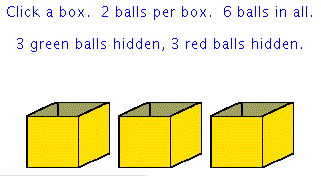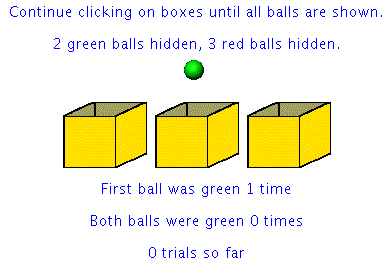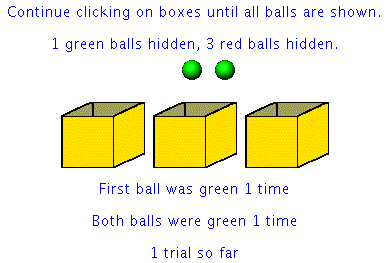What is Two Colors Applet?
This activity allows the user to simulate pulling red and green balls out of three boxes. The boxes are pre-arranged so that there are two red balls in one box, two green balls in another, and one green and one red ball in the third. The user can shuffle the order of the boxes and the order of the balls in the boxes.
To run in single trial mode, click on one of the boxes to see if the first ball is green. If it is, click on the box again to see if the second ball is green also. A count will be kept of the results. To run in multiple trial mode, enter the number of trials desired in the box and click on the run multiple trials button.
This applet allows the user to manipulate the number of trials to experiment with dependent event probability (also know as conditional probability). Dependent event probability is the chance that an outcome will occur if the first condition is met. To figure out the probability of the event occurring you must consider what effect the first event has on the second. In this applet the condition is that the first ball must be green. You can compare the number of times the first ball is green and the number of times both are green to figure out the conditional probability.
Probability began in the middle of the seventeenth century by a man named Pascal. One day a man proposed a question about gambling. His question was "If I play a game that I have eight rolls to roll a six and I fail the first three times, how much of my bet should I get back?" The game involved chance just as most of games do now, such as Monopoly and card games. Las Vegas is a city that is dominated by people that have invested in this field of mathematics. Today, probability has found its way into the fields of science, medicine, and statistics.
How Do I Use This Activity?
This activity allows the user to simulate drawing red and green balls out of boxes. To run in single trial mode, click on each of the boxes twice to reveal the color of the two balls each box contains. A count will be kept of how many times the first ball in the first box selected was green and how many times both balls in the first box selected were green. To run in multiple trial mode, enter the number of trials desired in the Number of Trials box and click on the Run Multiple Trials button.
Controls and Output
-
Three boxes are shown, each of which contains two balls. One box contains two red balls,
one box contains two green balls, and one box contains a red and a green ball (in no
particular order). An informational label will indicate how many red and green balls have
not yet been revealed.

-
Choose the box that you wish to discover the contents of and click on that box twice. If
the first ball drawn is green, 1 will be added to the total number of times when the first
ball was green. Also notice the informational label indicating how many red and green
balls are still hidden is updated.

-
Click the same box again. When the first box you choose has been clicked on twice, 1 is
added to the number of trials so far. If the second ball is also green, 1 will be added to
the total number of times when both balls are green. If the first ball is red, or if both
balls are red, 1 is added only to the number of trials so far.

-
To complete one trial, you must click twice on each of the other two boxes to reveal their
contents. When you are ready to attempt a new trial, just click the
Reshuffle Boxes Button. This button will be disabled while a trial is in progress.

-
To simulate more then one trial at once, type the desired number of trials in the
Number of trials: [___] space and click the
Run Multiple Trials button.

-
Each trial will be recorded in the statistics unless you choose to make a clean start. To
reset the totals, click on the
Reset Statistics button:

Description
This activity allows the user to simulate pulling red and green balls out of boxes, in order to understand the concept of conditional probability. This activity would work well in groups of two to three for about twenty minutes if you use the exploration questions and ten minutes otherwise.
Place in Mathematics Curriculum
This activity can be used to:
- introduce the notions of chance and probability
- motivate the notion of conditional probability
- motivate the notion of random numbers
Standards Addressed
Grade 9
-
Statistics and Probability
- The student demonstrates a conceptual understanding of probability and counting techniques.
Grade 10
-
Statistics and Probability
- The student demonstrates a conceptual understanding of probability and counting techniques.
Seventh Grade
-
Statistics and Probability
- Investigate chance processes and develop, use, and evaluate probability models.
Statistics and Probability
-
Conditional Probability and the Rules of Probability
- Understand independence and conditional probability and use them to interpret data
- Use the rules of probability to compute probabilities of compound events in a uniform probability model
-
Making Inferences and Justifying Conclusions
- Understand and evaluate random processes underlying statistical experiments
- Make inferences and justify conclusions from sample surveys, experiments, and observational studies
-
Using Probability to Make Decisions
- Calculate expected values and use them to solve problems
- Use probability to evaluate outcomes of decisions
Advanced Functions and Modeling
-
Data Analysis and Probability
- Competency Goal 1: The learner will analyze data and apply probability concepts to solve problems.
Be Prepared to
- answer the question "How do I make expectations based on the data?"
- discuss conditional probability